Located in the southeastern United States, the state of Georgia is a rich destination known for its historical heritage, natural beauty, and cultural diversity. With its coastal towns along the Atlantic Ocean and nature parks in the mountainous regions, it offers many travel routes catering to different interests. Georgia especially appeals to history enthusiasts and families with its Civil War-era structures, vibrant art scene, famous aquariums, and interactive museums.
From major metropolises like Atlanta to historic city centers like Savannah, from European-inspired towns like Helen to exotic wetlands like Okefenokee, every corner of the state is worth exploring. For travelers seeking hiking, beach vacations, historical tours, or cultural events, Georgia offers a wealth of experiences year-round. The state especially stands out with its nature parks and coastal islands, providing attractive alternatives for those looking for tranquility.
1. Savannah Historic District – Famous for its cobblestone streets, historic homes, and parks.
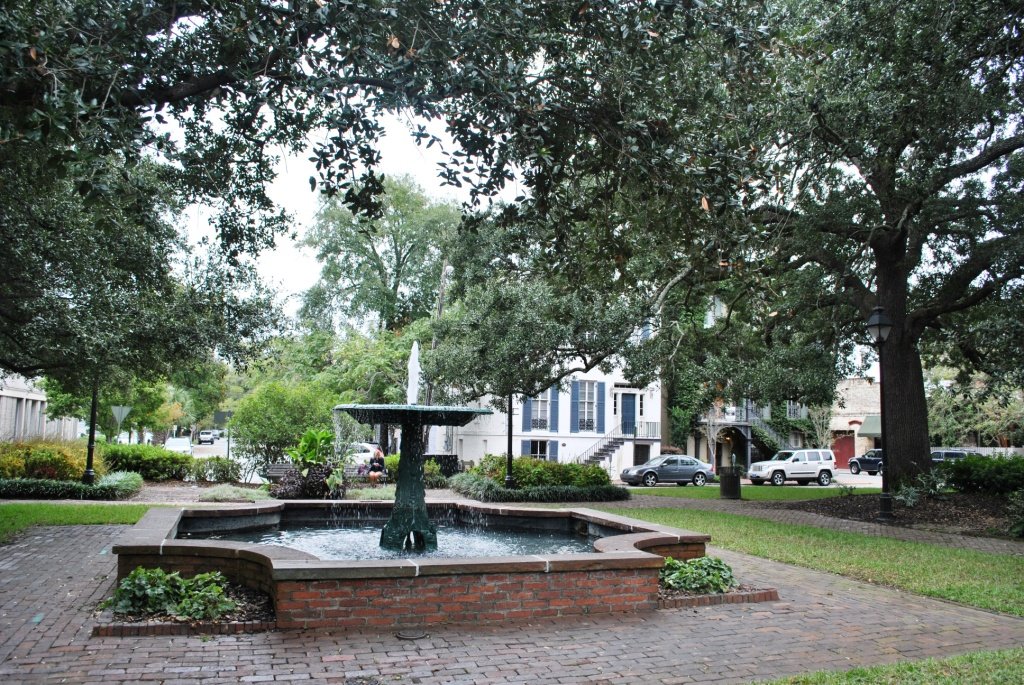
Savannah Historic District is one of the oldest and most impressive areas in Georgia. With its 18th-century cobblestone streets, historic homes featuring elegant architecture, and iconic parks, it offers visitors a true journey through time. The district stands out with its 22 geometrically arranged park spaces, and this planned city layout is considered one of the earliest examples of urban planning in America. Forsyth Park, a symbol of the city, is notable for its central fountain and surrounding walking paths.
Savannah Historic District is captivating not only for its visual appeal but also for its cultural and historical depth. Filled with Civil War monuments, antique shops, art galleries, and elegant cafés, the area is also famous for its ghost tours offering fascinating stories. During the day, it serves as an open-air museum for history and architecture enthusiasts, while at night, it reveals a romantic and mysterious side. Visitors to Savannah should definitely experience the unique ambiance of this historic district.
2. Atlanta – Georgia’s capital; known for Georgia Aquarium, World of Coca-Cola, and CNN Center.

Atlanta, as the capital and largest city of Georgia, combines cultural, historical, and modern attractions. The city is especially known for world-famous tourist spots such as the Georgia Aquarium, World of Coca-Cola, and CNN Center. The Georgia Aquarium, one of the largest in the world, houses thousands of marine creatures in its massive structure. Nearby, the World of Coca-Cola offers an entertaining experience with interactive exhibits that tell the story of the iconic beverage.
Atlanta also plays a significant role in American history. The Martin Luther King Jr. National Historical Park is a must-visit for those who want to understand the life and struggle of the civil rights leader. Piedmont Park, located in the city, is ideal for those who want to spend time surrounded by nature. With its developed transportation network, rich cuisine, art galleries, and vibrant music scene, Atlanta is a dynamic destination that offers both modern urban life and historical depth.
3. Blue Ridge Mountains – Ideal for hiking and scenic views.
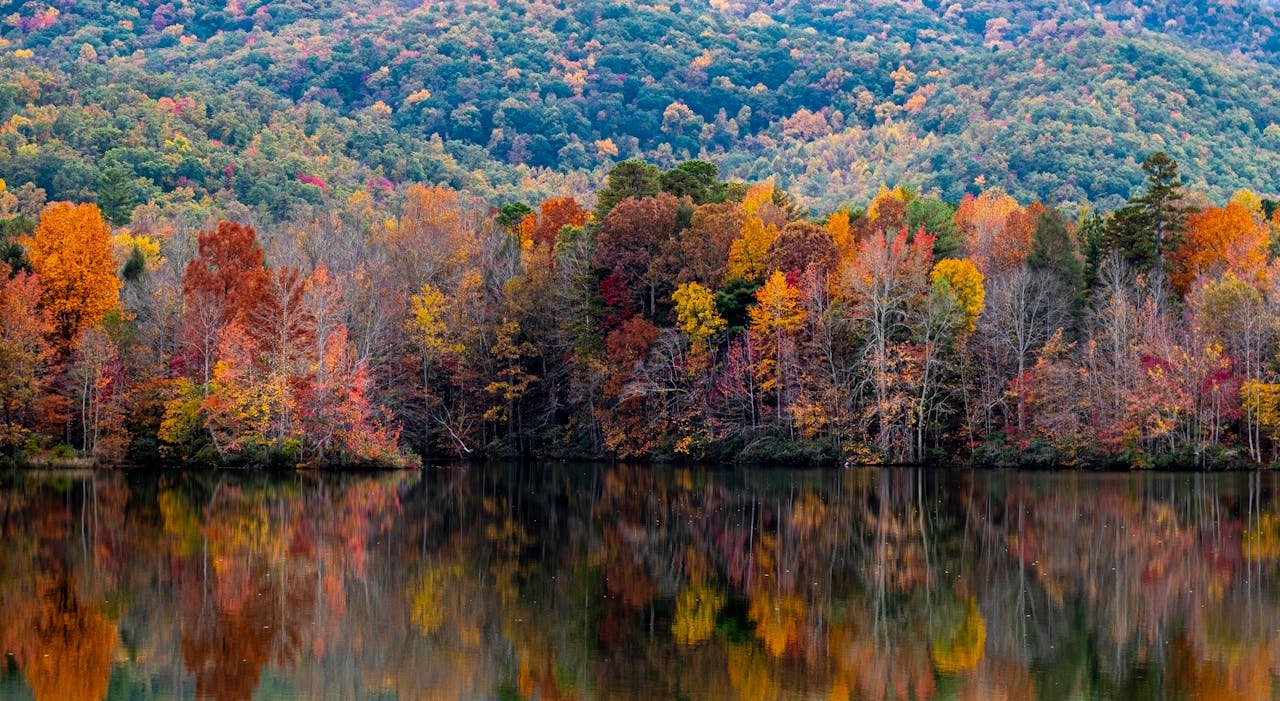
The Blue Ridge Mountains, located in northern Georgia and forming part of the Appalachian Mountain range, are an impressive mountain chain. This area is a perfect destination especially for nature lovers and outdoor activity enthusiasts. The Blue Ridge Scenic Railway, which runs through the mountains, offers visitors a nostalgic train ride accompanied by breathtaking views. Additionally, the Appalachian Trail, one of the most famous hiking routes, begins in these mountains and attracts many hikers throughout the year.
The nearby town of Blue Ridge blends mountain charm with urban life through its art galleries, boutique shops, and cozy cafés. In autumn, the region transforms into a postcard-like scene with vibrant red and golden hues as the leaves change color. With its waterfalls, forest trails, lakes, and mountain views, it is also a favorite spot for photographers and campers. For those seeking to escape the noise and connect with nature, the Blue Ridge Mountains are one of Georgia’s most peaceful and stunning regions.
4. Stone Mountain Park – A famous park known for its massive granite mountain and laser shows.
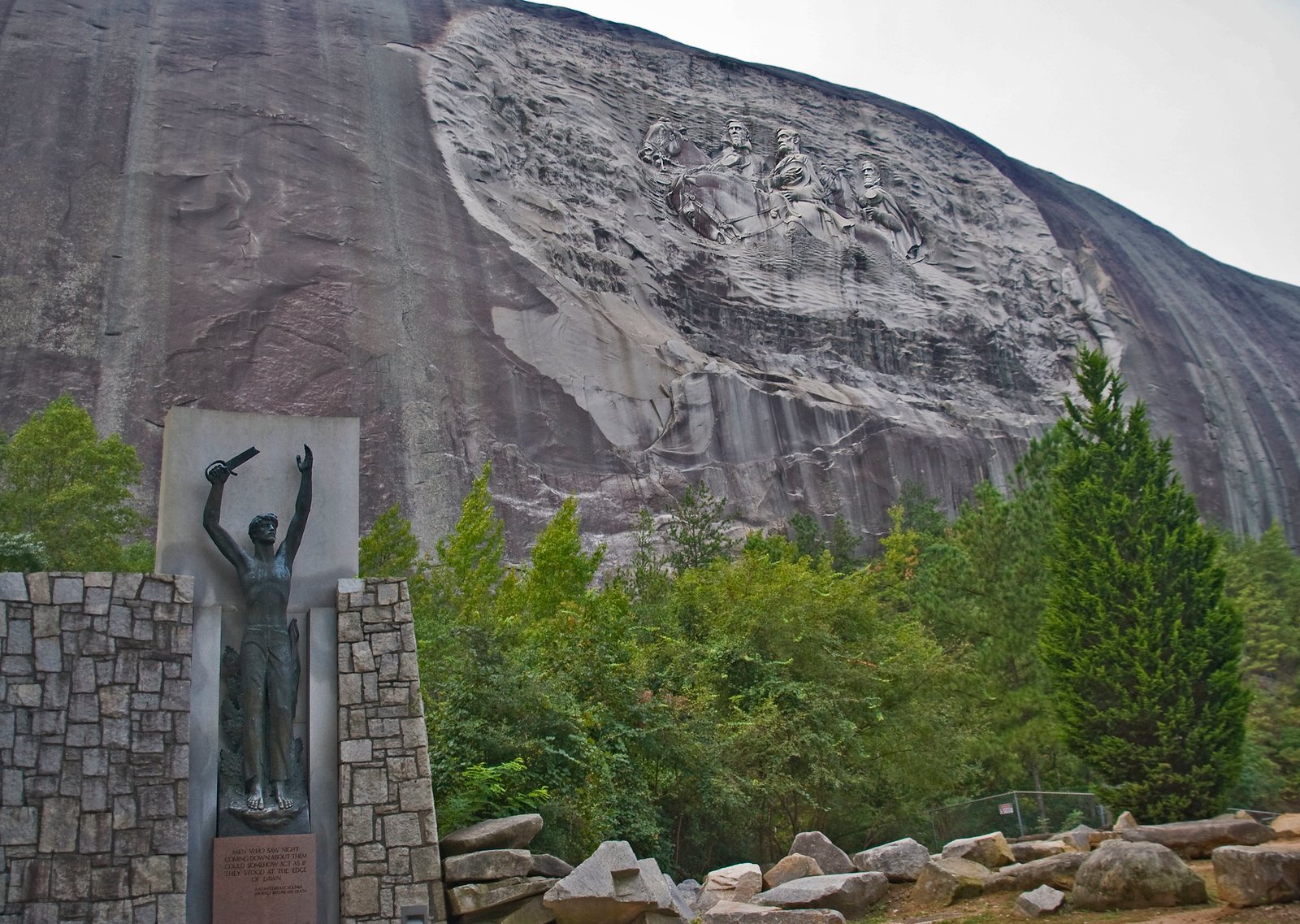
Stone Mountain Park is one of Georgia’s most visited natural and recreational areas. At the heart of the park stands Stone Mountain, one of the largest single pieces of exposed granite in the world, featuring a massive carving of three Confederate leaders from the American Civil War. Visitors can reach the summit via a cable car or enjoy the scenic hiking trails. From the top, panoramic views including the Atlanta skyline and surrounding nature can be seen in impressive detail.
The park is notable not only for its natural beauty but also for the variety of activities it offers. During the summer months, the laser light shows—combined with music and fireworks—create a spectacular visual experience. Additionally, it features boat rides, mini-golf, train tours, themed play areas for children, and interactive museums, making it ideal for families. With its blend of nature and entertainment, Stone Mountain Park provides one of the most comprehensive outdoor experiences in Georgia.
5. Callaway Gardens – A natural area filled with gardens, butterfly conservatories, and ponds.
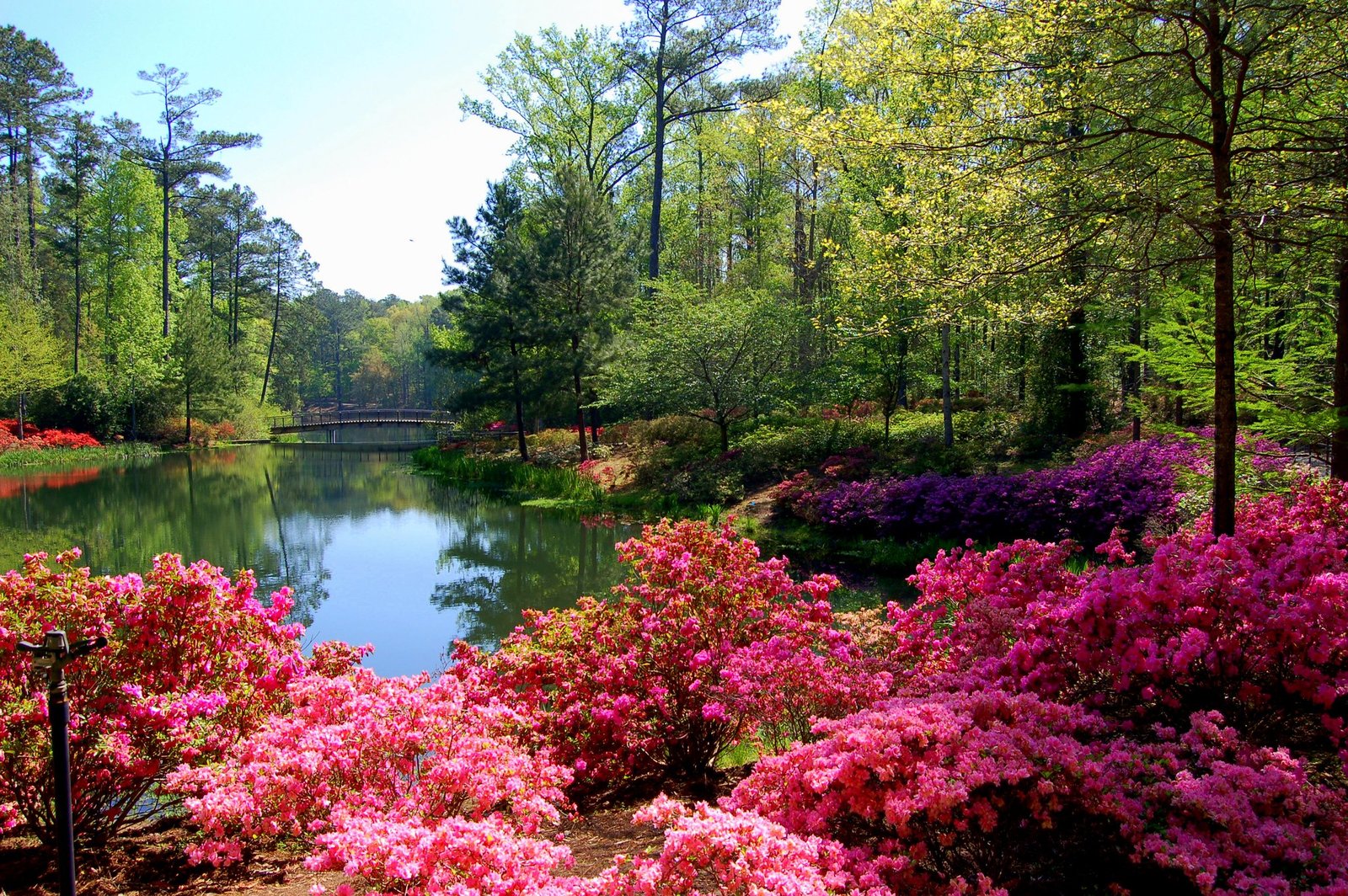
Callaway Gardens is a 2,500-acre natural paradise at the foothills of the Appalachian Mountains, established in 1952 by Cason and Virginia Hand Callaway. Originally created by restoring depleted farmland, the gardens have evolved into a park that houses one of the world’s largest collections of azaleas. Robin Lake Beach, a man-made white sand beach within the area, stands out, while hiking and biking trails, ponds, and lakeside picnic areas provide an ideal setting for various activities throughout the year.
One of the most remarkable attractions within the gardens is the Cecil B. Day Butterfly Center, considered the largest glass-enclosed butterfly conservatory in North America, home to over 1,000 butterflies. In addition, forest gardens integrated with natural habitats, birds of prey shows, adventure courses like Treetop Adventure, and golf courses offer visitors a combination of relaxation, education, and entertainment. These features make Callaway Gardens one of Georgia’s most unforgettable destinations for both nature lovers and families.
6. Okefenokee Swamp – A vast swamp area filled with alligators and birds.
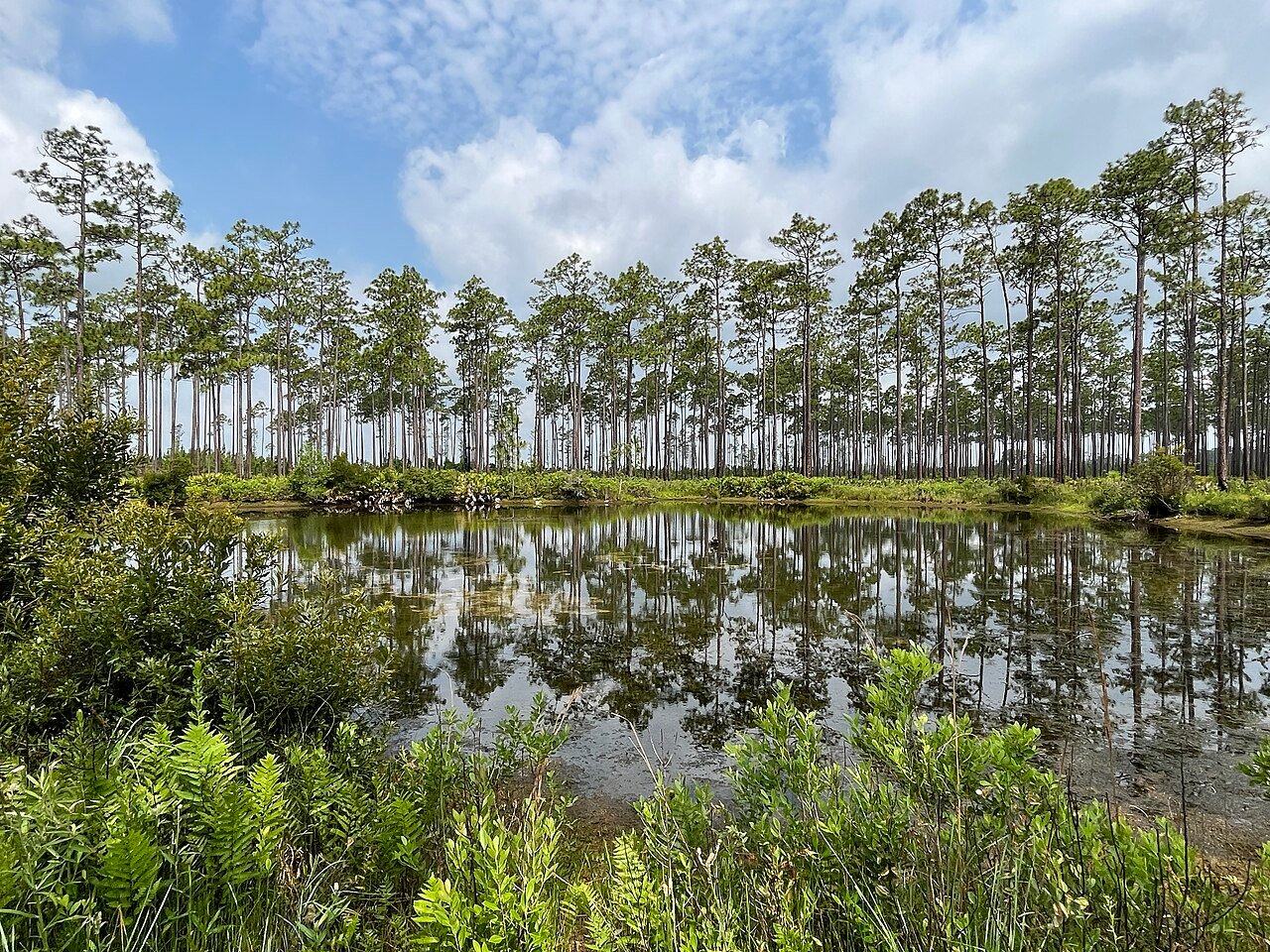
Okefenokee Swamp, located in southeastern Georgia, is a natural treasure and one of the largest swamp areas in the United States. Covering approximately 1,770 square kilometers, this vast wetland derives its name from a Native American term meaning “trembling earth.” Visitors can observe alligators, water snakes, fish, turtles, and over 200 species of birds in their natural habitat. Narrow waterways running through the swamp can be explored by canoe or boat tours, offering a unique experience immersed in nature.
Okefenokee is not only a natural wildlife area but also a unique ecosystem and cultural heritage site. In protected areas such as the Okefenokee National Wildlife Refuge and Stephen C. Foster State Park, visitors can learn more about the region’s nature and history through educational centers, hiking trails, and observation towers. The swamp offers unforgettable landscapes and experiences, particularly for nature photographers, bird watchers, and adventure seekers. For those looking to escape the noise and connect with the wild, Okefenokee Swamp is an ideal destination.
7. Jekyll Island – A holiday island known for its beaches, historic buildings, and bike trails.
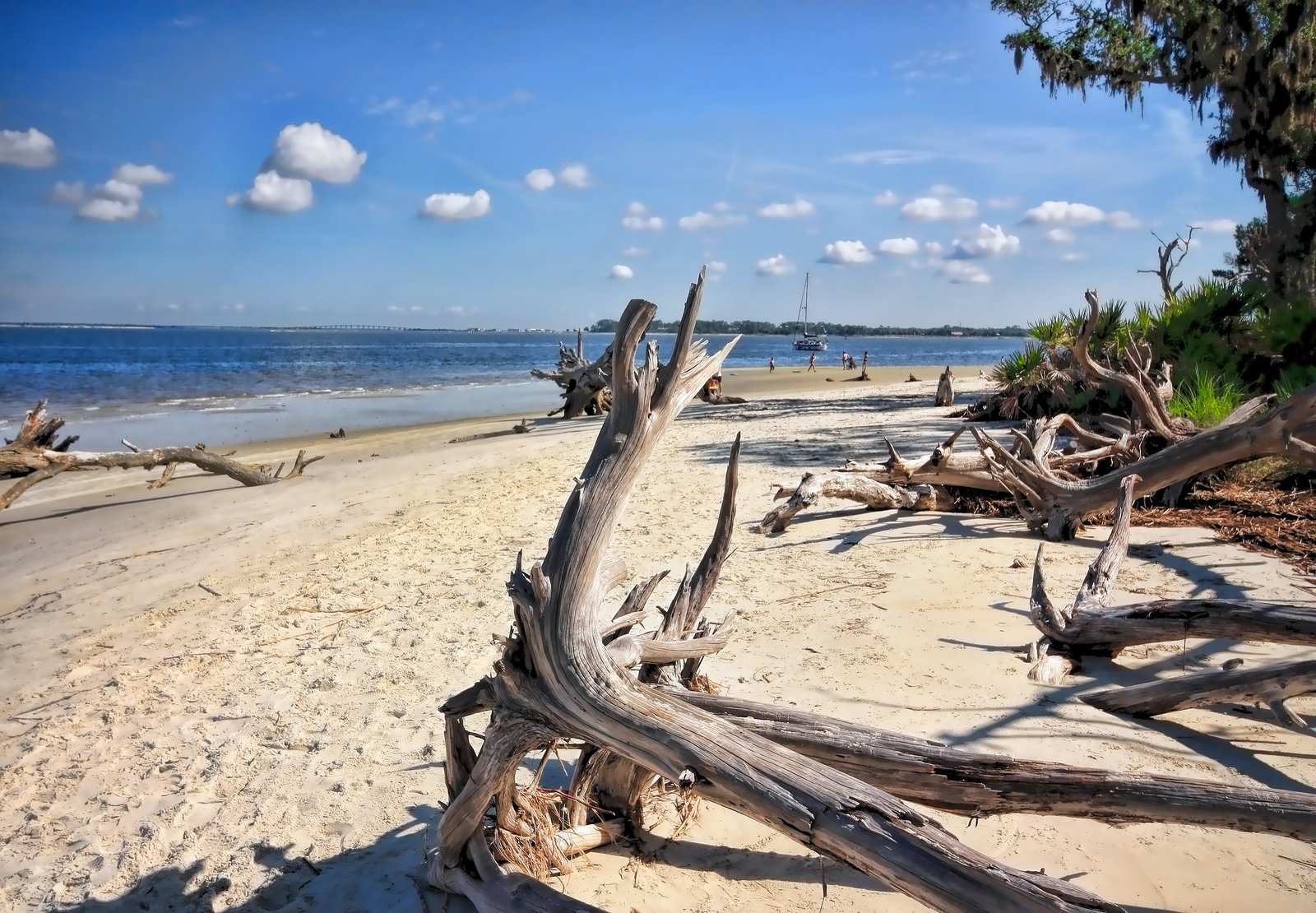
Jekyll Island is a captivating holiday island located off the coast of Georgia, blending rich history with natural beauty. Established in 1886 as a luxurious winter retreat by wealthy industrialists, the Jekyll Island Club Historic District spans 240 acres and includes 34 historic structures. Among these remarkable architectural landmarks are period buildings such as Faith Chapel, Horton House, and Moss Cottage, all meticulously restored and open for exploration. Visitors can learn about the island’s elite past through interactive museums and guided tours, discovering the architectural details that carry the marks of time.
The island’s natural beauty is just as striking as its history. Nearly 10 miles of beaches offer ideal spots for sunset views, while forest-lined stretches like Driftwood Beach provide unique scenes for photographers. Additionally, the island features 20–25 miles of paved bike trails that wind through forests, historic areas, and along the coastline, offering an active way to explore. Visitors can also learn about sea turtle rehabilitation at the Georgia Sea Turtle Center, enjoy hours of fun at the Summer Waves water park, or spend time in nature at the island’s golf courses. Jekyll Island offers an unforgettable destination for both history and nature lovers.
8. Tybee Island – A popular beach destination near Savannah.

Tybee Island is known as Savannah’s beach escape, located just 20 minutes from the city center. With around five miles of public beaches—North Beach, Mid Beach, South Beach, and Back River Beach—it offers a setting to suit every preference. North Beach is ideal for families, with easy access to restrooms, showers, and nearby restaurants. In contrast, Back River Beach is known for its tranquility and stunning sunset views, with calm waters perfect for fishing, kayaking, and paddleboarding.
For those interested in history and nature, Tybee Island is home to Georgia’s oldest and tallest lighthouse: the Tybee Island Lighthouse, a continuation of the original structure built in 1736, offering visitors panoramic views. Fort Pulaski National Monument is located on nearby Cockspur Island, accessible by river, and is famous for its Civil War-era defensive structures. Visitors can enjoy eco-kayak tours, explore the marine science center, observe wildlife, and see live alligators at popular spots like The Crab Shack—combining fun with learning.
Tybee Island offers a well-rounded beach and cultural experience, with its peaceful atmosphere, historical heritage, and unique outdoor activities, making it a must-visit during any trip to Savannah.
9. Georgia Aquarium (Atlanta) – One of the largest aquariums in the world.

Georgia Aquarium, the massive underwater world in Atlanta, stands out for both its size and the diversity of marine life it houses. With a total water capacity of approximately 11 million gallons (~41.6 million liters), it is the largest aquarium in the Western Hemisphere and held the world record from 2005 to 2012. The main exhibit, Ocean Voyager, holds 6.3 million gallons and is one of the largest single-tank exhibits in the world, allowing visitors to watch whale sharks, manta rays, groupers, and thousands of other sea creatures swim through a glass tunnel.
The experiences offered go beyond visual appeal; hundreds of species—including whale sharks, beluga whales, sea lions, dolphins, penguins, and sharks—are part of educational and conservation programs. Interactive exhibits and special galleries like “Sharks! Predators of the Deep” allow visitors to feel immersed in marine life through transparent tunnels. Additionally, themed events like “Glow Nights,” behind-the-scenes tours, and underwater performances at Sea Lion Studios provide unforgettable moments.
In conclusion, Georgia Aquarium offers an educational and inspiring experience, opening the door to the vast world of marine life with its global scale, interactive exhibits, and conservation-focused mission.
10. World of Coca-Cola (Atlanta) – An interactive museum showcasing the history of Coca-Cola.

World of Coca‑Cola is an interactive museum in Atlanta that showcases the unique brand story of Coca‑Cola from its beginnings in 1886 to its current global icon status. Opened in 2007 at Pemberton Place, this 20-acre complex captivates visitors with exhibits that explore the origins of the beverage known as “liquid gold” and its rise to worldwide fame. One of the highlights is “The Vault,” a chamber that resembles a secret safe, where the legendary formula is displayed. The Coca‑Cola Stories exhibit takes guests on an immersive journey through time among historic artifacts.
The visit is filled with numerous interactive experiences: the Taste It! area offers the chance to sample over 60 to 100 different soft drinks from around the world; Scent Discovery explores the link between scent and taste; and a 4-D theater combines history, animation, and motion seats. Visitors can also watch the live bottling process, take a photo with the Polar Bear mascot, and explore galleries filled with vintage packaging and antique advertisements from Coca‑Cola’s pop culture legacy. As a result, World of Coca‑Cola becomes an unforgettable Atlanta experience for both families and anyone interested in brand history.
11. Martin Luther King Jr. National Historical Park (Atlanta) – The birthplace and memorials of the civil rights leader.
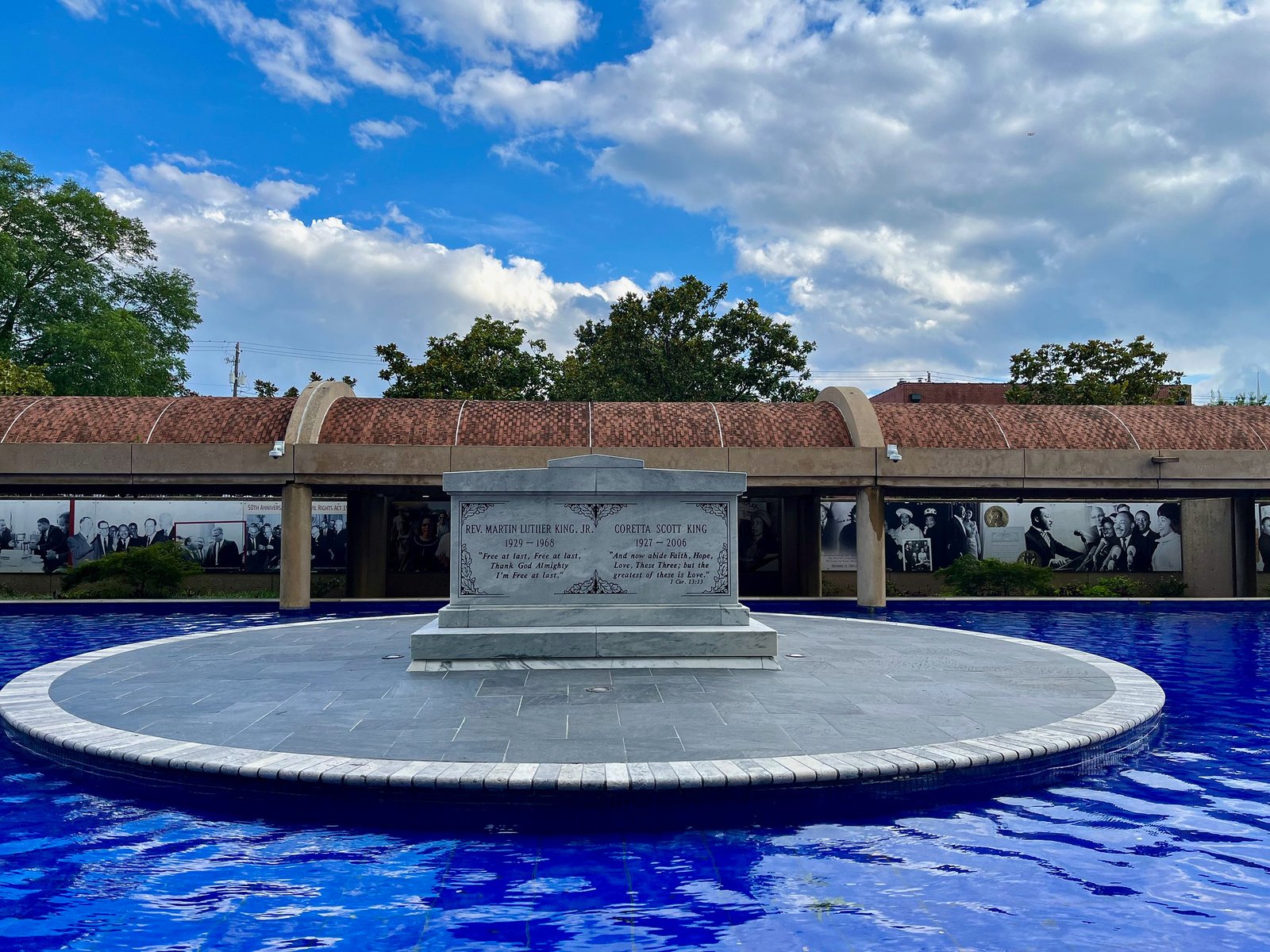
Martin Luther King Jr. National Historical Park in Atlanta spans approximately 35 acres and is protected by the U.S. National Park Service as one of the most meaningful areas dedicated to the life of civil rights leader Dr. King. The park includes his family’s birth home, the historic Ebenezer Baptist Church where both Dr. King and his father served as pastors, the “Sweet Auburn” neighborhood where he was born, and the “I Have a Dream” rose garden. Visitors can gain a deep understanding of King’s life and legacy through free guided tours of the birth home, exhibits at the Visitor Center featuring period artifacts like postage stamp displays, and multimedia presentations such as “Courage to Lead.”
The park also houses the King Center for Nonviolent Social Change (The King Center), where the tombs of Dr. King and his wife Coretta Scott King are located. The gravesite is surrounded by a reflecting pool and an eternal flame, creating a serene and commemorative atmosphere. Additionally, the International Civil Rights Walk of Fame is an open-air exhibit in the park honoring the names of key figures in the civil rights movement. Each step along this path symbolizes the ongoing struggle for peace and equality, making the park not only a historical site but also a deeply moving memorial.
12. Forsyth Park (Savannah) – A large city park famous for its fountain.
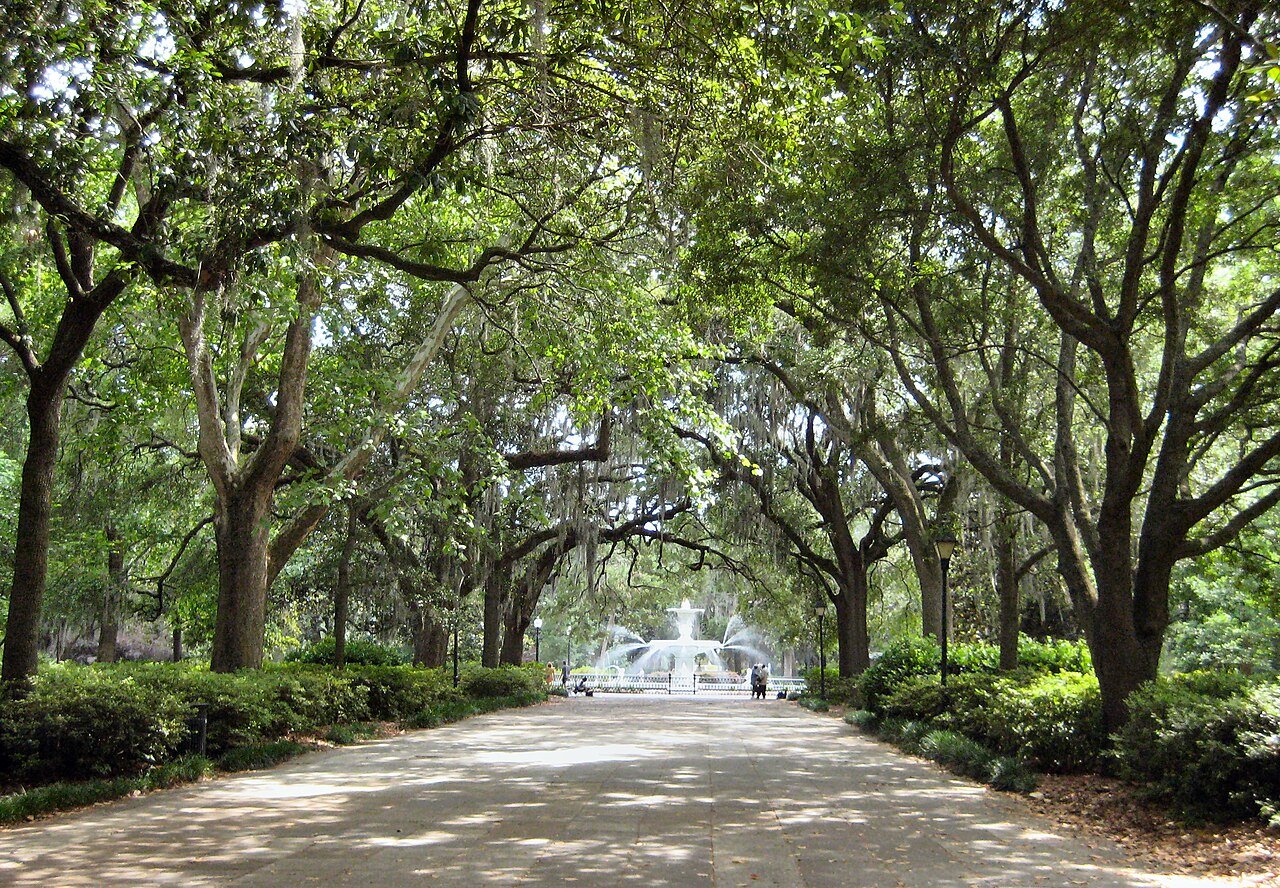
Forsyth Park is Savannah’s largest and oldest city park, covering approximately 30 acres. Built on land donated in the 1840s by William Brown Hodgson, the park is named after John Forsyth, the 33rd governor of Georgia. At the northern end stands the iconic Forsyth Fountain, installed in 1858 and modeled after the fountains of Paris’s Place de la Concorde. This cast-iron structure has been featured in numerous films and photo shoots and is famously dyed green during St. Patrick’s Day, making it a traditional focal point of celebration.
More than just a green space, the park has become a social and cultural hub for both locals and tourists. Towering oak trees, well-maintained walking paths, sports fields, children’s playgrounds, and features like the fragrant garden for the visually impaired attract visitors of all ages. Forsyth Park also hosts weekly farmers’ markets, open-air concerts, art festivals, and community events, adding vibrancy to city life. With its historical charm, natural beauty, and community engagement, Forsyth Park is one of the highlights of exploring Savannah.
13. Driftwood Beach (Jekyll Island) – A shoreline offering striking views for photographers.
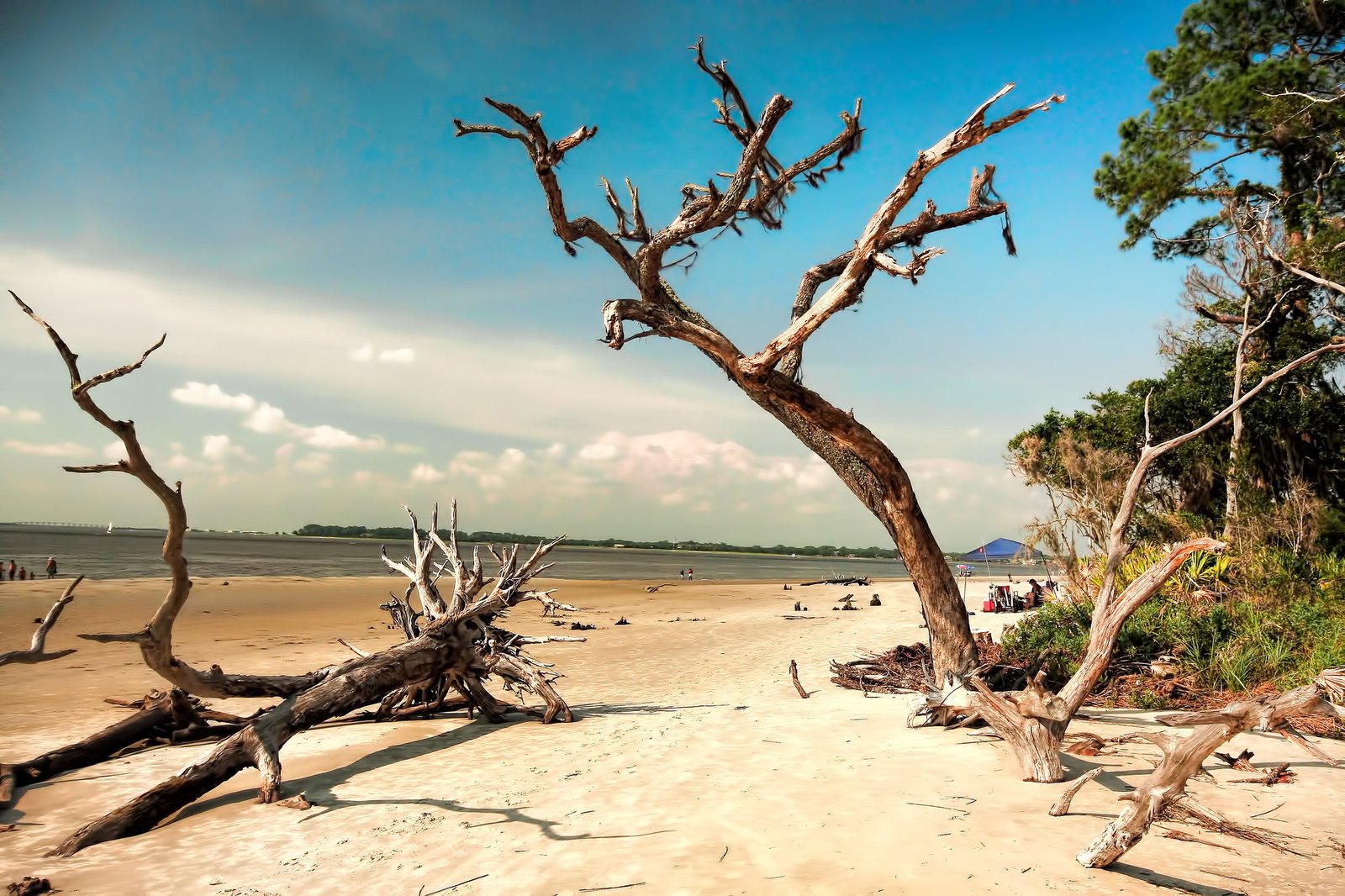
Driftwood Beach (Jekyll Island) is a magical stretch of shoreline located on Georgia’s northern coast. It resembles an open-air art gallery, where the trunks and roots of ancient oak and pine trees—slowly eroded by the sea—are scattered across the sand. This otherworldly setting, where wood and sand meet, forms a hauntingly beautiful landscape. The area offers particularly dramatic photo opportunities at sunrise and sunset, when the lighting enhances the surreal atmosphere.
The beach’s unique silhouette makes it a magnet for photographers, artists, and nature lovers. Panoramic views, twisted tree shapes, and calm waters create an ideal scene at any time of day—especially during low tide, when the driftwood is fully exposed. The beach is also popular for horseback riding, stargazing, light hiking, and picnicking. While local regulations prohibit removing driftwood, visitors are free to enjoy the peaceful surroundings and connect with nature in silence.
14. Athens – A cultural city known for its live music scene and the University of Georgia.
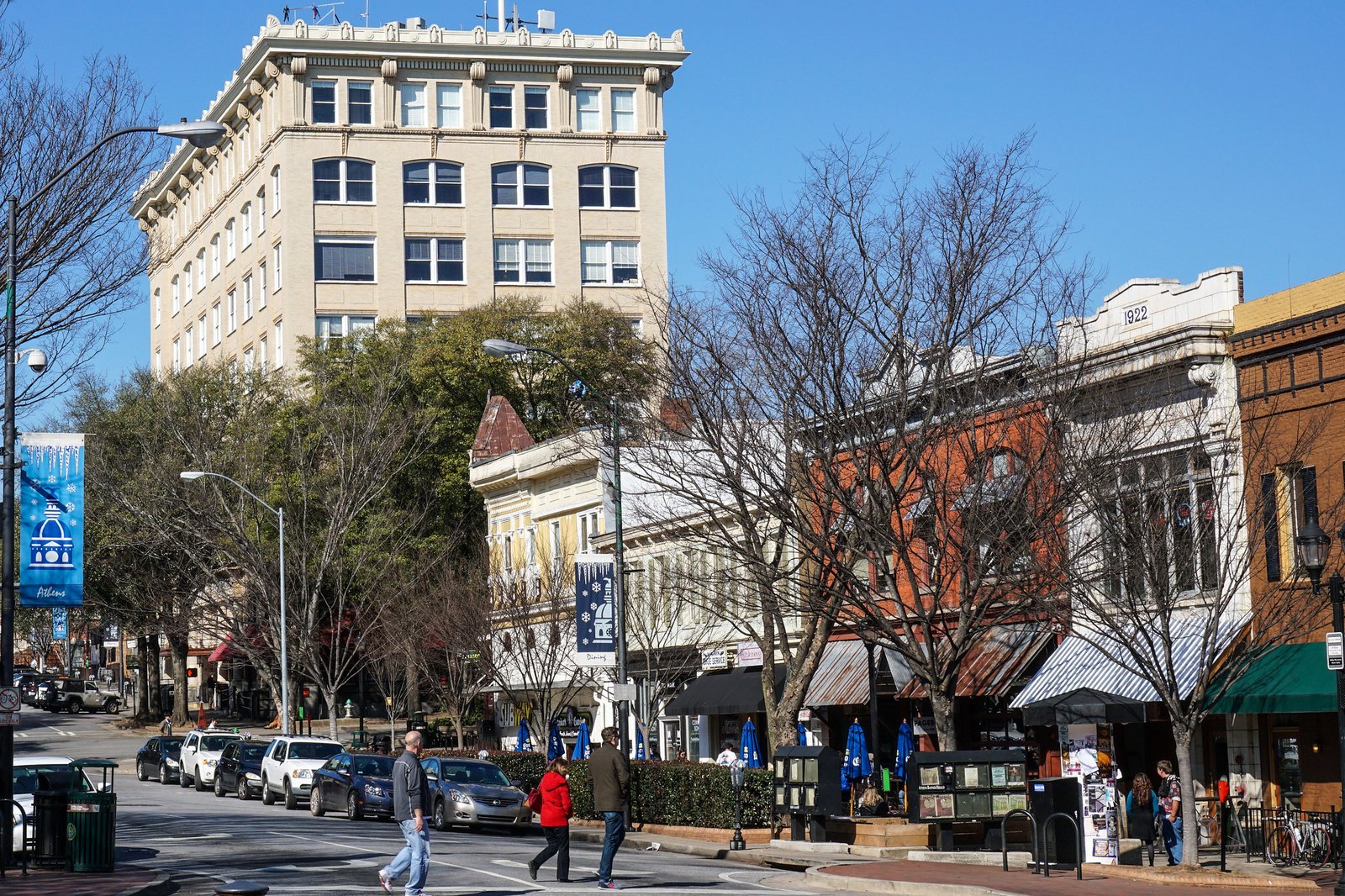
Athens, Georgia, is a dynamic hub that blends a college town atmosphere with music and culture. Shaped by the founding of the University of Georgia in 1801, the city—often referred to as the “Classic City”—stands out with its historic buildings, botanical gardens, and Greek Revival architecture, all intertwined with campus life. In addition to its student population, Athens offers a lively and creative environment with its unique cafés, boutique shops, and walkable downtown.
What truly sets Athens apart is its powerful music scene. Known as the “Live Music Capital of the South,” it has inspired world-famous bands such as The B-52’s, R.E.M., Widespread Panic, Drive-By Truckers, and of Montreal. Legendary venues like the 40 Watt Club and Georgia Theatre in the downtown area host both local and international artists, while festivals like AthFest fill the summer with colorful events. Cultural landmarks such as the Morton Theatre and Nuçi’s Space also serve as key centers for supporting artists.
15. Tallulah Gorge State Park – A natural wonder filled with a deep canyon, hiking trails, and waterfalls.

Tallulah Gorge State Park is a dramatic natural wonder located in northeastern Georgia, near the town of Tallulah Falls. Stretching about 2 miles (3.2 km) in length and plunging nearly 1,000 feet (300 meters) deep, it is one of the most impressive canyons on the U.S. East Coast. Among the park’s most striking features are views of six distinct waterfalls and popular cascades like Hurricane Falls, which can be accessed via stairways descending into the gorge. Visitors can also cross a high suspension bridge for panoramic views and get up close to nature at the bottom of the narrow river valley. A permit system—limited to 100 per day—offers nature enthusiasts the rare opportunity to explore the canyon floor.
The park features over 20 miles (32 km) of hiking and mountain biking trails. For easier access, the North and South Rim trails stretch about 3 miles along the canyon’s edge, providing multiple scenic overlooks. Adventure-seekers can take steeper trails like Sliding Rock Trail to get closer to the waterfalls. Additionally, the Shortline Trail, built on a former railroad bed, offers a flat, scenic route ideal for cycling or running. With activities such as rock climbing, whitewater rafting (on scheduled water release days), picnicking, and birdwatching, the park appeals to all ages and skill levels.
Overall, Tallulah Gorge State Park offers a unique experience with its breathtaking canyon views, abundant waterfalls, and a variety of trails that invite visitors to discover and enjoy nature.
16. Providence Canyon State Park – Known as “Georgia’s Little Grand Canyon.”
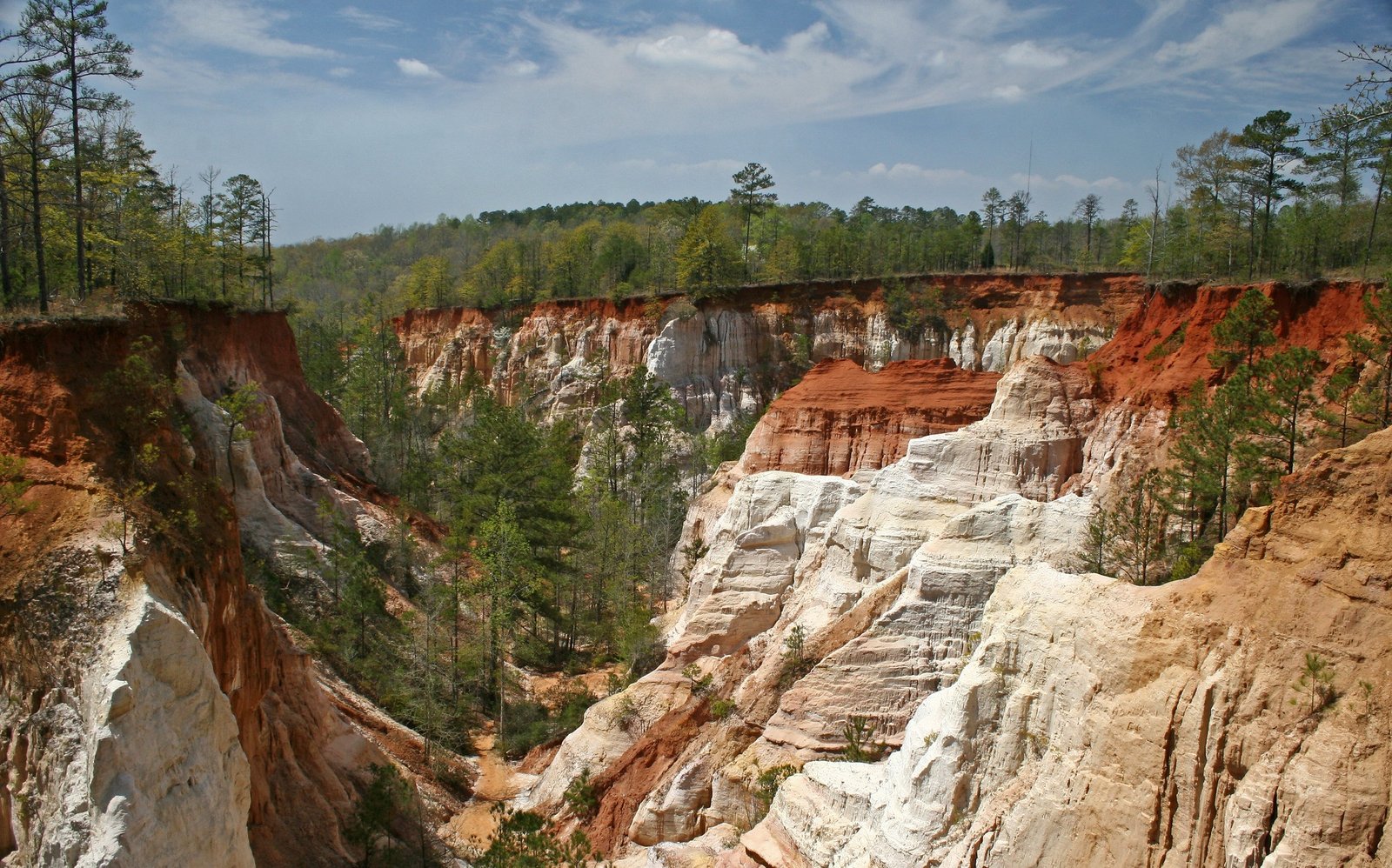
Providence Canyon State Park stands out as both a natural beauty and a landscape uniquely shaped by human impact. Covering approximately 1,003 acres, the park is often referred to as “Georgia’s Little Grand Canyon” and captivates visitors with its colorful canyons that plunge up to 150 feet deep. Interestingly, this dramatic landscape was formed as a result of poor agricultural practices in the 1800s, where excessive land clearing and erosion created deep gullies—turning the site into both a natural wonder and a cautionary environmental tale.
The park is ideal for nature lovers and photographers who want to witness the colorful soil layers up close. Hiking trails, especially the 2.5-mile Canyon Loop Trail, allow exploration along the canyon rims. For more adventurous visitors, the seven-mile Backcountry Trail and the “Canyon Climbers Club” offer the chance to descend into various parts of the canyon. During summer, the rare plumleaf azalea blooms, and in autumn, the canyon is framed by vibrant fall foliage. With minimal light pollution, the park is also an excellent spot for stargazing. Providence Canyon is a striking destination that blends the power of nature with a living lesson in human environmental impact.
17. Helen – A mountain town known for its Bavarian-style architecture.
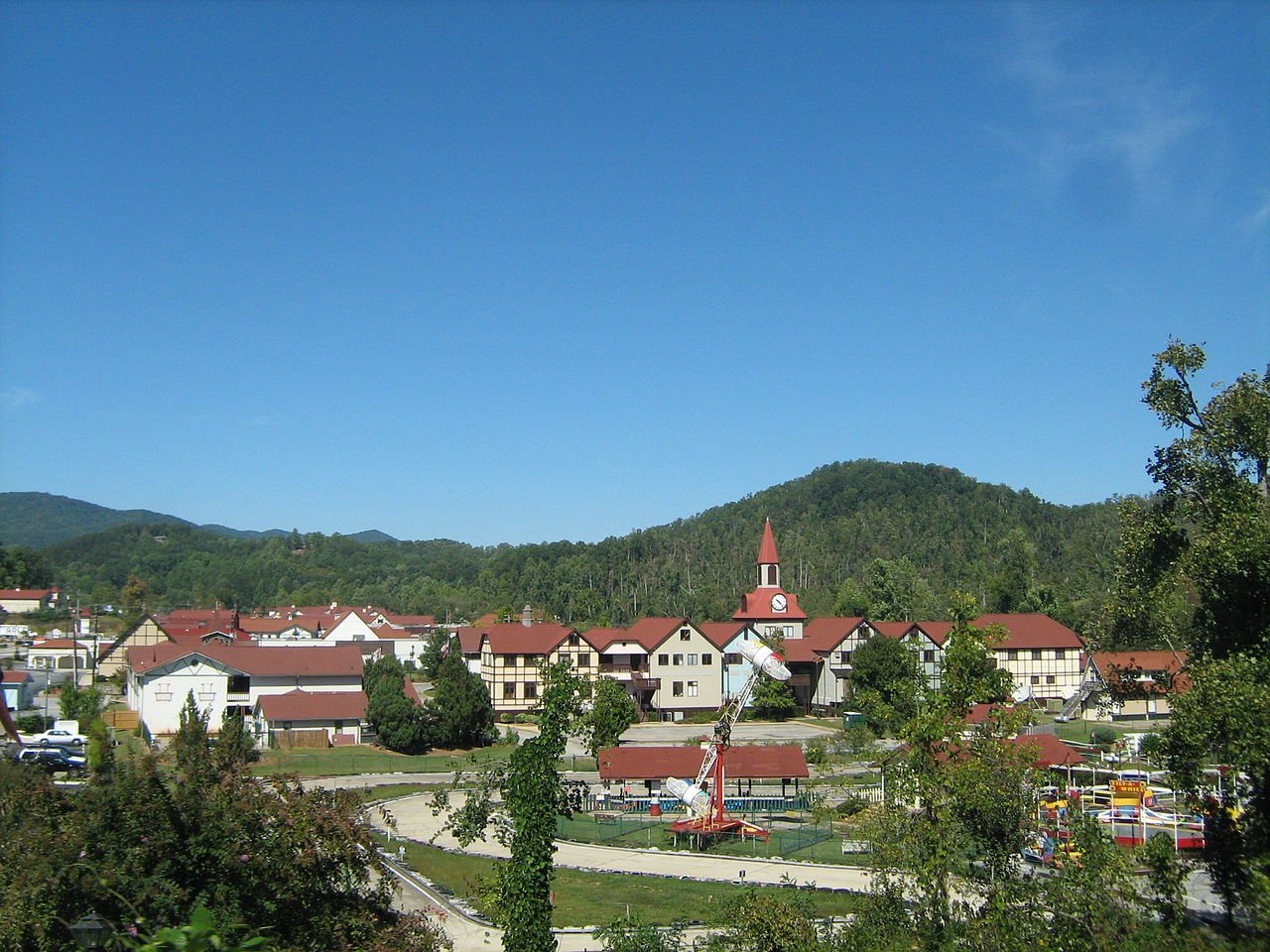
Helen, Georgia—known as an “Alpine Village”—underwent an economic transformation in the late 1960s, becoming the Southeast U.S.’s unique Bavarian-themed destination. Formerly a logging town, Helen was redesigned in 1969 under a special zoning ordinance requiring all buildings to reflect traditional architecture from southern Germany. With cobblestone streets, half-timbered houses, and steeply pitched towers, the town took on the charming appearance of a Bavarian village.
This themed architecture significantly boosted tourism—despite having a population of only about 600, Helen now attracts millions of visitors annually. The town features German restaurants serving bratwurst and schnitzel instead of sushi, apple strudel, and hosts year-round events like Oktoberfest in the fall and a Christmas market in winter. Nearby attractions such as Unicoi State Park, tubing along the Chattahoochee River, zip-lining adventures, and Anna Ruby Falls offer both cultural and outdoor experiences.
With its scenic beauty and distinctive European village feel, Helen is one of Georgia’s most interesting and photogenic corners. Local wine made from regional grapes, artisan galleries, and peaceful tubing trips on the Chattahoochee River enhance the town’s appeal. This blend makes Helen an unforgettable destination for road trippers and nature-loving travelers alike.
18. Chattahoochee River National Recreation Area – Ideal for water sports and nature hiking.
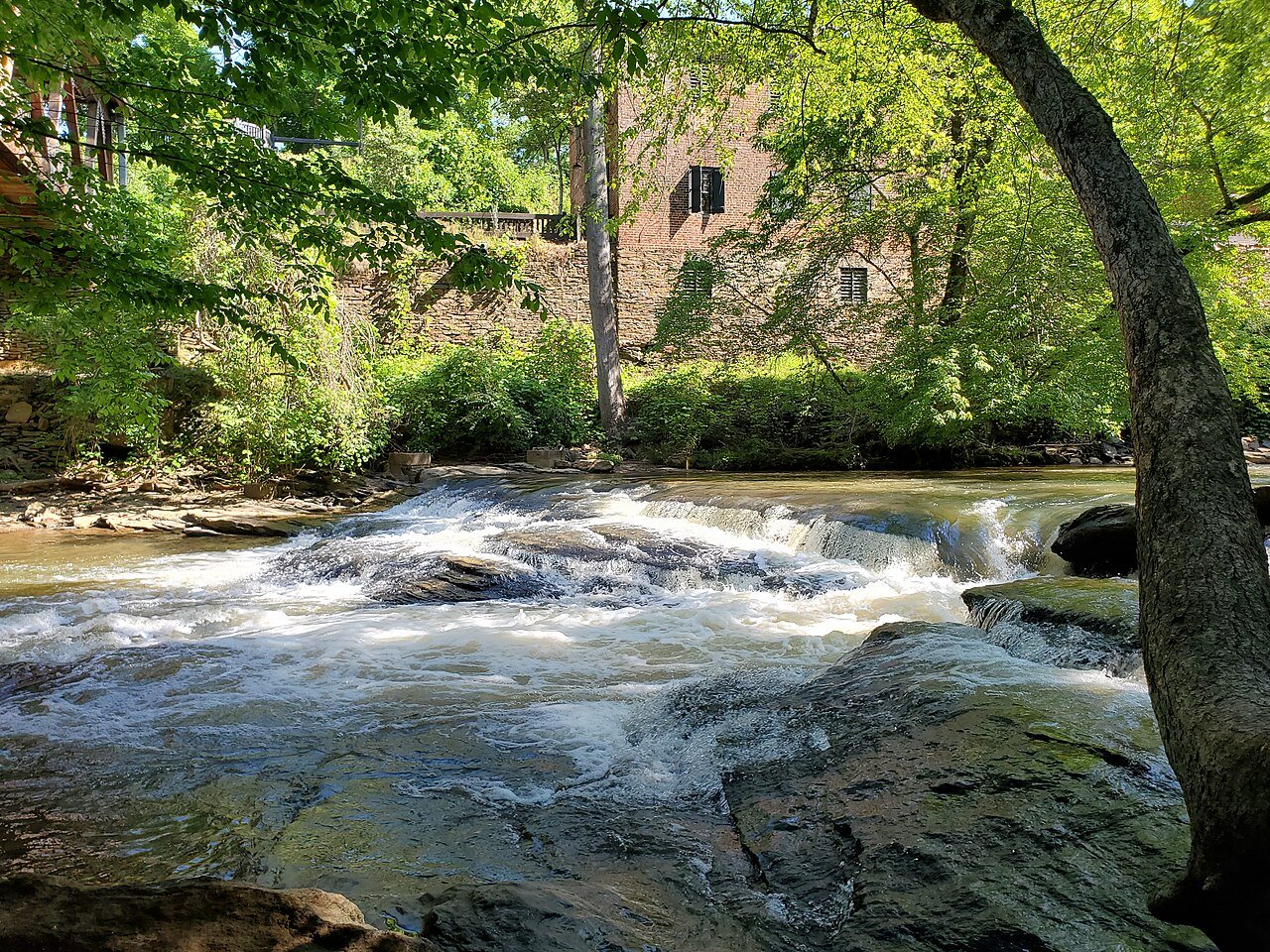
Chattahoochee River National Recreation Area consists of 15 separate park units along a 48-mile (77 km) stretch of the Chattahoochee River through the Atlanta metropolitan area. Established in 1978, the area offers a wide range of activities along the river, including hiking, biking, fishing, canoeing, rafting, tubing, and birdwatching. Stretching from Lake Lanier down to the southern parts of Atlanta, the park provides urban visitors with a “nature within the city” experience.
It features a variety of scenic trails for hiking, such as the 3-mile Cochran Shoals Fitness Loop, the East/West Palisades trails, and the Vickery Creek Trail with views of waterfalls and moonlit scenery. The park is also a popular spot for canoeing, tubing, and rafting, with rental services available from companies like NOC. In addition, the natural areas are home to wildlife like squirrels, water turtles, and various bird species, making it ideal for picnicking and birdwatching.
Overall, Chattahoochee River National Recreation Area is an outdoor haven that offers a close-to-the-city nature escape, water sports opportunities, diverse trails, and a rich ecosystem. Appealing to a wide range of visitors—from families and adventure seekers to photographers and nature education groups—it is a must-visit destination in the Atlanta area.
19. Cumberland Island National Seashore – Famous for its wild nature, historic ruins, and wild horses.
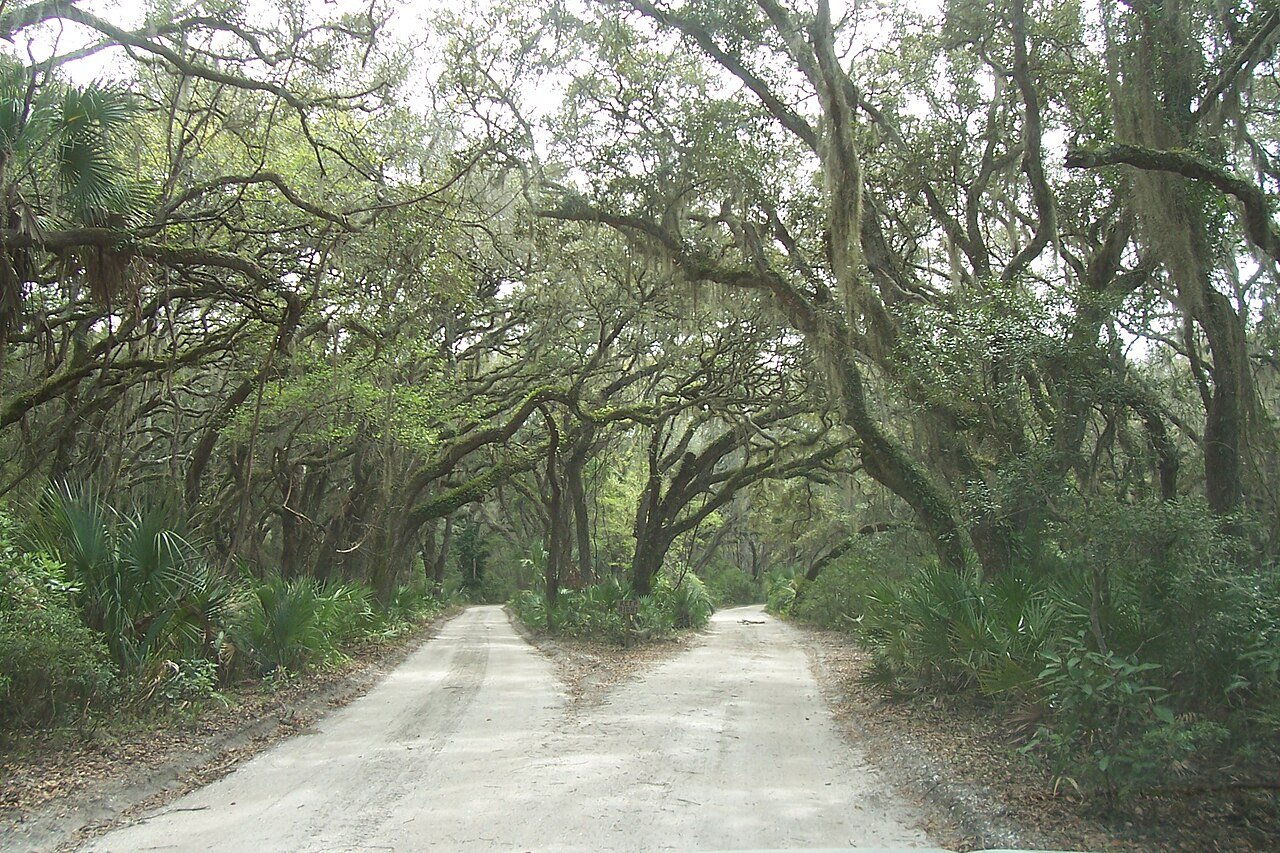
Cumberland Island National Seashore is a captivating 17,000-acre coastal island located in southeastern Georgia. The island features pristine beaches, expansive salt marshes, maritime forests, and a rich blend of historic structures. Architectural landmarks such as Dungeness and Plum Orchard—once owned by the Carnegie family—along with centuries-old ruins that have transformed into natural works of art, are scattered across the island. Accessible only by ferry, the island offers a unique atmosphere where limited human presence allows visitors to fully immerse themselves in its historical silence and untouched nature.
The island is particularly known for its wild, free-roaming horses. Believed to have arrived in the 18th century, these horses have become fully feral over time, with an estimated 150–200 now inhabiting the island. While they are a major attraction for visitors, their ecological impact has sparked debates, and efforts toward conservation and balance remain ongoing. Authorized hiking, camping, biking tours, and culturally rooted local sites also make Cumberland a memorable escape for nature and history enthusiasts.
20. Fox Theatre (Atlanta) – Historic theater building and performing arts center.

Fox Theatre is an iconic building located at the corner of Peachtree Street and Ponce de Leon in Atlanta, opened in 1929. Originally intended to serve as the Yaarab Temple for the Shriners, a Masonic organization, the project proved too costly and was completed with support from cinema mogul William Fox, transforming it into a luxurious movie palace. With a seating capacity of 4,665, the theater was designed in the Moorish Revival style, enriched with Islamic and Ancient Egyptian influences. Its ceiling, featuring stars and moving cloud projections, creates the illusion of an atmospheric open-air courtyard.
Over time, as television and modern cinemas rose in popularity, the Fox Theatre lost its audience, but was restored in the 1970s thanks to strong community support and revived as a performing arts venue. Today, it hosts a wide range of events including Broadway productions, concerts, film screenings, and special occasions. One of the theater’s most striking features is the massive Möller organ named “Mighty Mo,” which complements its decor inspired by the Bosphorus and Middle Eastern motifs. Voted the best music venue in Georgia by local readers, the Fox Theatre remains one of the city’s cultural landmarks, celebrated for both its architectural heritage and vibrant event atmosphere.
